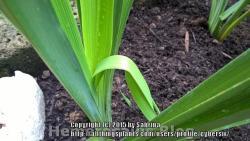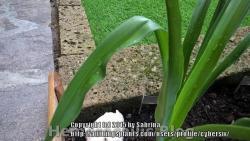cybersix said:. The PH is about 8 I read many consider this a "slightly" alkaline soil, nothing to worry about, but I'll keep things checked. I was planning to order a kit for soil analysys, they are not too expensive.
A pH of 8 is actually above the "slightly alkaline" range and is considered "moderately alkaline". The pH scale is logarithmic so a pH of 8 is ten times more alkaline than a pH of 7, and a pH of 5 is 100 times more acidic than a pH of 7 (I might have explained this in the other thread, not sure, sorry if I'm repeating myself

)
Were any of the "many" talking specifically about daylilies, because different kinds of plants have different preferred pH ranges - at pH 8 you'd have real problems growing azaleas or rhododendrons for example. Daylily cultivars differ in their tolerance for higher pH's so some will get interveinal chlorosis at a lower pH than others.
There is no published research information on preferred daylily pH ranges but Sinclair Adam, who did some research on daylily nutrition a number of years ago, recommends a range of 5.5 to 6.5 in this article
http://pss.uvm.edu/ppp/pubs/oh... )
Waaay back in the 1950's in a book about daylilies (Daylilies and How To Grow Them), Ben Arthur Davis wrote "If an exact standard of soil acidity could be set up for daylilies, it would probably be around pH 6.5.........A soil showing pH of around 7 (neutral) will ordinarily give fair results..................If, however, the soil is definitely alkalline, aluminum sulphate or sulphur should be used to bring about the necessary change............That is, if the pH is, let us say 7.5, the amounts of acidifying materials suggested above would be necessary to bring it down to 6.5......"
Because there are other factors that can influence a plant's response to soil pH, we removed a recommended pH range from the AHS FAQ, relying instead on the fact that the plants will tell you, as yours did, if they're not happy.
A soil test kit will tell you what's in the soil, but to find out what nutrients the plant is actually able to acquire from that soil needs a leaf tissue analysis. That's primarily what the PDF article you mentioned is about.
Looking again at this picture of interveinal chlorosis in a daylily (while the next one to it was quite happy at the same pH), this was manganese deficiency caused by high pH. Like iron, there can be ample manganese in the soil but the pH blocks it from being used by the plants and that's what leaf analysis and soil analysis showed in the case in the picture (not my daylilies but I was involved in the diagnostic process):
http://www.daylilies.org/ahs_d...
There was plenty of iron and manganese in the soil test but the leaf test showed that the plants were unable to utilize the manganese because of the pH although they were managing to get enough iron. The lab recommendation was to lower the pH with sulfur and that fixed the problem last I heard (this is going back quite a few years).
Anyway, this was a long-winded way of saying that while a pH of 8 may not bother some other plants, there are daylily cultivars that may well find it quite a bit too high. This is not an uncommon problem with daylilies.




